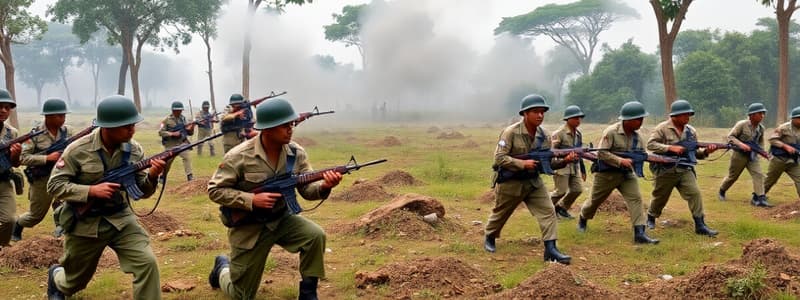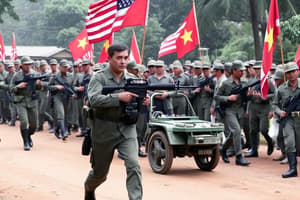Podcast
Questions and Answers
How did the Domino Theory influence US involvement in Vietnam?
How did the Domino Theory influence US involvement in Vietnam?
- It led the US to support Ho Chi Minh as a nationalist leader against French colonial rule.
- It justified US intervention to prevent the spread of communism throughout Southeast Asia. (correct)
- It encouraged the US to remain neutral to avoid appearing imperialistic.
- It promoted diplomatic solutions and negotiations with North Vietnam.
What was the primary justification used by the US government for its military actions in Vietnam following the Gulf of Tonkin Incident?
What was the primary justification used by the US government for its military actions in Vietnam following the Gulf of Tonkin Incident?
- To support a unified Vietnam under communist rule.
- To enforce United Nations resolutions against North Vietnam.
- To protect French colonial interests in Indochina.
- To retaliate against alleged attacks on US naval vessels and prevent further aggression. (correct)
Why did the US support the overthrow of Ngo Dinh Diem, despite initially backing his regime?
Why did the US support the overthrow of Ngo Dinh Diem, despite initially backing his regime?
- Diem requested the US government to orchestrate his removal from power.
- Diem formed an alliance with North Vietnam, undermining the US efforts.
- Diem embraced communist ideologies, conflicting with US strategic goals.
- Diem's corruption, authoritarian practices, and persecution of Buddhists led to widespread instability. (correct)
How did the Viet Cong's guerilla warfare tactics primarily impact the US military strategy in Vietnam?
How did the Viet Cong's guerilla warfare tactics primarily impact the US military strategy in Vietnam?
What was the strategic objective of the US military's 'search and destroy' missions in Vietnam?
What was the strategic objective of the US military's 'search and destroy' missions in Vietnam?
Which of the following is an example of tactics used by the Vietnamese forces during the Vietnam War?
Which of the following is an example of tactics used by the Vietnamese forces during the Vietnam War?
What was the intended impact of the American protest movement on public opinion regarding the Vietnam War?
What was the intended impact of the American protest movement on public opinion regarding the Vietnam War?
What characterized the opposition to the Vietnam War within the US military itself?
What characterized the opposition to the Vietnam War within the US military itself?
Which of the following protest strategies was most commonly employed during the Vietnam War era?
Which of the following protest strategies was most commonly employed during the Vietnam War era?
How did television coverage influence American public opinion about the Vietnam War?
How did television coverage influence American public opinion about the Vietnam War?
What was the significance of the My Lai Massacre in shaping public opinion about the Vietnam War?
What was the significance of the My Lai Massacre in shaping public opinion about the Vietnam War?
Which of the following figures was a prominent leader or voice in the anti-Vietnam War movement?
Which of the following figures was a prominent leader or voice in the anti-Vietnam War movement?
What role did student activism play in the anti-Vietnam War movement?
What role did student activism play in the anti-Vietnam War movement?
Why did some Americans oppose the Vietnam War on economic grounds?
Why did some Americans oppose the Vietnam War on economic grounds?
Which event significantly escalated American involvement in the Vietnam War?
Which event significantly escalated American involvement in the Vietnam War?
What was a key difference between the tactics used by the US military and the Viet Cong?
What was a key difference between the tactics used by the US military and the Viet Cong?
What long-term impact did the Vietnam War have on American foreign policy?
What long-term impact did the Vietnam War have on American foreign policy?
Which of the following describes a key outcome of the anti-Vietnam War movement?
Which of the following describes a key outcome of the anti-Vietnam War movement?
What was the primary goal of 'Vietnamization' under President Richard Nixon?
What was the primary goal of 'Vietnamization' under President Richard Nixon?
What impact did the Vietnam War have on the relationship between the US government and its citizens?
What impact did the Vietnam War have on the relationship between the US government and its citizens?
Flashcards
Domino Theory
Domino Theory
The theory that if one country falls to communism, neighboring countries will also fall.
Overthrow of Diem
Overthrow of Diem
The U.S. supported coup that removed Ngo Dinh Diem from power in South Vietnam in 1963.
Gulf of Tonkin Incident
Gulf of Tonkin Incident
A naval incident in 1964 that led to increased U.S. involvement in the Vietnam War.
US vs. Vietnam Tactics
US vs. Vietnam Tactics
Signup and view all the flashcards
American Protest Styles
American Protest Styles
Signup and view all the flashcards
Key Anti-War Figures
Key Anti-War Figures
Signup and view all the flashcards
Methods of Protest
Methods of Protest
Signup and view all the flashcards
Impact of Protests
Impact of Protests
Signup and view all the flashcards
Opposition within Military
Opposition within Military
Signup and view all the flashcards
Study Notes
- The Indochina Wars encompass conflicts in the region, notably the Vietnam War, shaped by complex political and ideological factors.
Causes of the Vietnam War
- The Vietnam War's roots lie in a combination of events, motivations, and involved parties, significantly escalating the conflict.
- The Domino Theory posited that if one country in Southeast Asia fell to communism, others would follow, influencing US interventionist policy.
- The US supported the coup against Ngo Dinh Diem due to his unpopularity and oppressive rule, contributing to political instability in South Vietnam.
- The Gulf of Tonkin Incident, involving alleged attacks on US ships, led to the Gulf of Tonkin Resolution, granting President Johnson broad war powers.
Tactics: US versus Vietnam
- US forces relied on superior firepower, air mobility, and technological advancements.
- Examples of US tactics included strategic bombing campaigns (Operation Rolling Thunder) and search and destroy missions.
- Vietnamese forces employed guerrilla warfare tactics, utilizing knowledge of the terrain, tunnel systems, and support from the local population.
- Examples of Vietnamese tactics included ambushes, booby traps, and the Ho Chi Minh Trail for supply transport.
- The effectiveness of US tactics was limited by the challenging terrain, the resilience of the Vietnamese forces, and the political constraints of the war.
- The effectiveness of Vietnamese tactics lay in their ability to inflict casualties, disrupt US operations, and sustain the war effort despite material disadvantages.
American Protests
- American protests against the Vietnam War took various forms, reflecting widespread dissent and moral opposition.
- Famous protests included large-scale demonstrations in Washington D.C., teach-ins on college campuses, and draft card burnings.
- Key figures in the anti-war movement included activists, intellectuals, and politicians who mobilized public opinion against the war.
- Methods of protest ranged from peaceful marches and rallies to civil disobedience and acts of resistance.
- Protests significantly influenced public opinion, contributing to growing disillusionment with the war and demands for peace.
- Opposition within the military manifested through acts of dissent, resistance, and desertion, reflecting the war's divisive impact on American society.
- Strategies used during protests varied, with causes rooted in moral outrage, political disillusionment, and a desire for peace.
- Outcomes and impacts of protests included increased public awareness, shifts in political discourse, and pressure on policymakers to de-escalate the war.
Studying That Suits You
Use AI to generate personalized quizzes and flashcards to suit your learning preferences.




